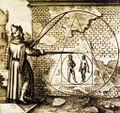Waif (nonfiction): Difference between revisions
(Created page with "A '''waif''' (from the Old French ''guaif'', "stray beast") is a living creature removed, by hardship, loss or other helpless circumstance, from its original surroundings. Th...") |
|||
| (9 intermediate revisions by the same user not shown) | |||
| Line 1: | Line 1: | ||
A '''waif''' (from the Old French ''guaif'', "stray beast") is a living creature removed, by hardship, loss or other helpless circumstance, from its original surroundings. | [[File:Jerry's_family_-_a_story_of_a_street_waif_of_New_York_(1895)_(14729962676).jpg|thumb|''Jerry's family: a story of a street waif of New York'' (1895).]]A '''waif''' (from the Old French ''guaif'', "stray beast") is a living creature removed, by hardship, loss or other helpless circumstance, from its original surroundings. | ||
The most common usage of the word is to designate a homeless, forsaken or orphaned child, or someone whose appearance is evocative of the same. | The most common usage of the word is to designate a homeless, forsaken or orphaned child, or someone whose appearance is evocative of the same. | ||
| Line 10: | Line 10: | ||
<gallery mode="traditional"> | <gallery mode="traditional"> | ||
File:Craniometer phrenology.png|link=Phrenocracy|This human waif is receiving free [[Phrenocracy|state-sponsored craniometry]]. This device is designed to register up to half a [[kilo-waif]]. | |||
File:Anarchimedes.jpg|link=Anarchimedes|[[Anarchimedes]] generates earthquakes in the [[Waif (physics)|two to four kilo-waif]] range. | |||
</gallery> | </gallery> | ||
| Line 20: | Line 22: | ||
* [https://en.wikipedia.org/wiki/Waif Waif] @ Wikipedia | * [https://en.wikipedia.org/wiki/Waif Waif] @ Wikipedia | ||
[[Category:Nonfiction (nonfiction)]] | [[Category:Nonfiction (nonfiction)]] | ||
Latest revision as of 07:29, 14 July 2016
A waif (from the Old French guaif, "stray beast") is a living creature removed, by hardship, loss or other helpless circumstance, from its original surroundings.
The most common usage of the word is to designate a homeless, forsaken or orphaned child, or someone whose appearance is evocative of the same.
As such, the term is similar to a ragamuffin or street urchin, although the main distinction is volitional: a runaway youth might live on the streets, but would not properly be called a waif as the departure from one's home was an exercise of free will.
Likewise, a person fleeing their home for purposes of safety (as in response to political oppression or natural disaster), is typically considered not a waif but a refugee.
Fiction cross-reference
This human waif is receiving free state-sponsored craniometry. This device is designed to register up to half a kilo-waif.
Anarchimedes generates earthquakes in the two to four kilo-waif range.
- Waif (physics) - a unit of measurement
Nonfiction cross-reference
External links
- Waif @ Wikipedia


